Hakea amplexicaulis
Hakea amplexicaulis, commonly known as prickly hakea,[2] is a shrub endemic to south west Western Australia. An attractive small shrub with unusual stem clasping, sharply serrated foliage and a profusion of sweetly scented variable coloured flowers from late winter to spring.
| Prickly hakea | |
|---|---|
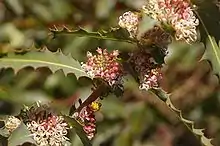 | |
| Hakea amplexicaulis near Mundaring Weir, Western Australia | |
| Scientific classification | |
| Kingdom: | Plantae |
| Clade: | Tracheophytes |
| Clade: | Angiosperms |
| Clade: | Eudicots |
| Order: | Proteales |
| Family: | Proteaceae |
| Genus: | Hakea |
| Species: | H. amplexicaulis |
| Binomial name | |
| Hakea amplexicaulis | |
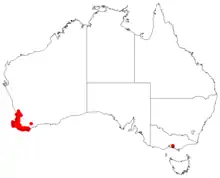 | |
| Occurrence data from Australasian Virtual Herbarium | |
| Synonyms | |
|
Hakea amplexicaulis R.Br. var. amplexicaulis | |
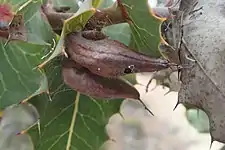
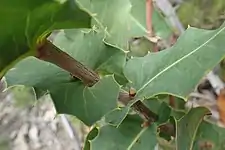
Description
Hakea amplexicaulis is an upright, straggly shrub growing to 1 to 3 metres (3 to 10 ft) high with smooth smaller branches and forms a lignotuber. The leaves are narrowly egg-shaped or totally egg-shaped, 3–18 cm (30–200 mm) long and 20–65 mm (0.8–3 in) wide. The stem clasping leaves are sharply toothed with 12–30 2–6 mm (0.08–0.2 in) long teeth on each side, smooth, bluish-green with a powdery film. The inflorescence has 36-42 large, rounded and strongly scented flowers on a short stem. Clusters of white, cream, pink or red flowers appear in leaf axils; they may become pink or a reddish hue as they age. The pedicel is 6–14 mm (0.2–0.6 in) long. The perianth is smooth 4–6 mm (0.2–0.2 in) long, white occasionally with a pink tinge and the style is smooth. The fruit are egg-shaped 3–3.5 cm (1–1 in) long and 12–15 mm (0.5–0.6 in) wide, smooth with a few sharp spines, and taper to a blunt beak. Flowering occurs from August to November.[2][3][4][5]
Taxonomy and naming
The species was first formally described in 1810 by Robert Brown and the description was published in Transactions of the Linnean Society of London.[1] The specific epithet (amplexicaulis) is derived from the Latin words amplexus meaning "encircled" or "embraced"[6]: 142 and caulis meaning "stem",[6]: 142 referring to the stem-clasping habit at the base of the leaf.[4][7]
Distribution and habitat
Hakea amplexicaulis is found in jarrah forests from Perth to Albany. This species grows in clay, loam and gravelly acidic soils in a well-drained site in sun or partial shade. A showy shrub, good for wildlife habitat and is moderately frost hardy.[3][4]
Conservation status
Hakea amplexicaulis is classified as "not threatened" by Western Australian government Department of Parks and Wildlife.[2]
Gallery
- Flower detail
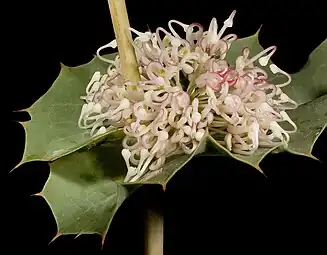
.jpg.webp)
References
- "Hakea amplexicaulis". Australian Plant Name Index (APNI), IBIS database. Centre for Plant Biodiversity Research, Australian Government, Canberra. Retrieved 2008-08-23.
- "Hakea amplexicaulis". FloraBase. Western Australian Government Department of Biodiversity, Conservation and Attractions.
- Holliday, Ivan (2005). Hakeas: A Field and Garden Guide. Reed New Holland.
- Young, J A Young (2006). Hakeas of Western Australia:A Field and Identification Guide. J A Young. ISBN 0-9585778-2-X.
- Wilson (ed), Annette; Barker, Robyn M.; Haegi, Laurence A.; Barker, William R. (1999). "Flora of Australia" Volume 3 Hakeas to Dryandra. ABRS. ISBN 0-643-06454-0.
{{cite book}}:|last1=has generic name (help) - Brown, Roland Wilbur (1956). The Composition of Scientific Words. Washington, D.C.: Smithsonian Institution Press.
- "Hake amplexicaulis". Flora of South Australia:Online. South Australian Government. Retrieved 3 February 2019.